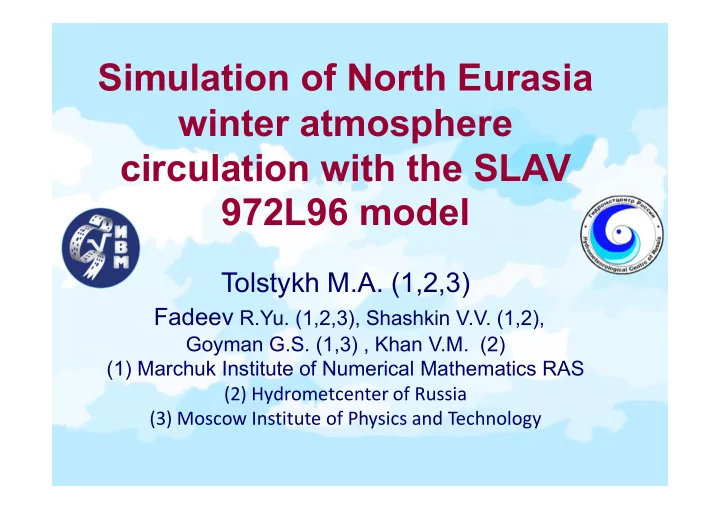

Simulation of North Eurasia winter atmosphere circulation with the SLAV 972L96 model Tolstykh М.А. (1,2,3) Fadeev R.Yu. (1,2,3), Shashkin V.V. (1,2), Goyman G.S. (1,3) , Khan V.M. (2) (1) Marchuk Institute of Numerical Mathematics RAS (2) Hydrometcenter of Russia (3) Moscow Institute of Physics and Technology
SL-AV global atmosphere model SL-AV: S emi -L agrangian, based on A bsolute V orticity equation • Finite-difference semi-implicit semi-Lagrangian dynamical core of own development. Vorticity- divergence formulation, unstaggered grid (Z grid), 4 th order finite differences, variable resolution in latitude, possibility to use reduced lat-lon grid (Tolstykh et.al., Geosci.Mod.Dev., 2017). • Many parameterisation algorithms from ALADIN/ALARO (except for radiation and land surface) • The model can run at 9072 cores with 63 % efficiency (at 13608 cores with 52 % efficiency) .
SL-AV is currently applied for: • Medium-range operational forecast at Hydrometcenter of Russia; • Subseasonal and seasonal forecasts at Hydrometcentre (with the old version), also S2S; • Short-range prediction in Novosibirsk
Sources of subseasonal predictability (Vitart, 2012) • Sea surface temperature • Land conditions (surface temperature, snow cover, vegetation characteristics, albedo,…) • Sea ice • Madden-Julian oscillation (MJO) • El-Nino-Southern oscillation (ENSO) • North-Atlantic oscillation (NAO) • Stratospheric variability (sudden stratosphere warmings, quasi-biennial oscillation, …)
North-Atlantic Oscillation index Winter index is relatively predictable by the models !
Correlations of winter NAO index and T2m: old SL-AV model (left) and NCEP/NCAR2 reanalysis (right) Courtesy of V.Khan Making NAO forecast better would provide practically useful winter T2m seasonal forecast over significant part of N.Eurasia
Sources of NAO predictability (A.Scaife et al 2014) - El-Nino-Southern Oscillation (ENSO) - Atlantic Ocean - Kara sea-ice - Quasi Biennial Oscillation
Quasi-biennial oscillation in SLAV (V.Shashkin et al Russ Met. And Hydr. 2019) SL-AV – top, ERA I - bottom
SLAV972L96 MSLP (top), T2m (bottom) for winter(left), summer (right) (from Fadeev et al, Russ. Meteor. and Hydr. 2019)
DJF zonal mean U-wind: model (left), ERA-I (right) (from Shashkin et al, Russ. Meteor and Hydr. 2019 N1)
DJF zonal mean Temperature: model (left), ERA-I (right) (from Shashkin et al, Russ. Meteor and Hydr., 2019 N1)
T2m error (left), idem for its anomaly (right)
Old and new long-range prediction system at Hydrometcentre of Russia SL-AV 2015 SL-AV 2008 • Resolution 1,4х1,125° lon- • Resolution 0,9х0,72° lon-lat, 96 lat, 28 levels levels • Uppermost level at 5 hPa • Uppermost level at 0,04 hPa • 1.5-3 km resolution in the • 500-700 m resolution in the stratosphere stratosphere • SW radiation: CLIRAD SW, LW • SW and LW radiation: Ritter, radiation: RRTMG LW (11 + 16 Geleyn 1992 (1+1 band) spectral bands) • Boundary layer – improved • Boundary layer: Bastak-Duran et al version of Geleyn 1982 JAS 2014 • Marime stratoculumus, sea-ice T • ISBA surface scheme • INM RAS mulilayer soil scheme • 4 months forecast in 40 min • 4 months forecast in 40 min at 480 at 8 cores of Cray XC40 cores of Cray XC40
Some technology features Old version: •Initial data uncertainty - breeding •Model uncertainty – perturbation of parameterisation parameters (2 so far) New version: •Initial data uncertainty – LETKF centered to operational objective analysis •Model uncertainty – as currently (but 4-6 parameters) + equivalent of SKEB
NAO index ACC comparison for old and new SL-AV model (1991-2010) November December January February DJF Lead time 0 month 1 month 2 months 3 months 1 month SL-AV old 0.46 -0.08 0.14 0.29 0.17 SL-AV 0.78 -0.09 0.29 0.34 0.29 new
Future work • Improve stochastic mechanisms in the model (increase No. of perturbations for model parameterizations parameters and implement an equivalent of SKEB). • Land surface scheme data assimilation (S.Makhnorylova’s talk). • Operational implementation of LETKF centered to operational analysis (talks by V.Mizyak, V. Rogutov). • Development of operational technology for coupled model (R.Fadeev’s talk)
Conclusions • SLAV972L96 model reproduces main atmosphere characteristics • It is supposed to switch the operational subseasonal and seasonal forecasts to the new version once the technology is ready.
Thank you for attention! http://nwplab.inm.ras.ru
Recommend
More recommend